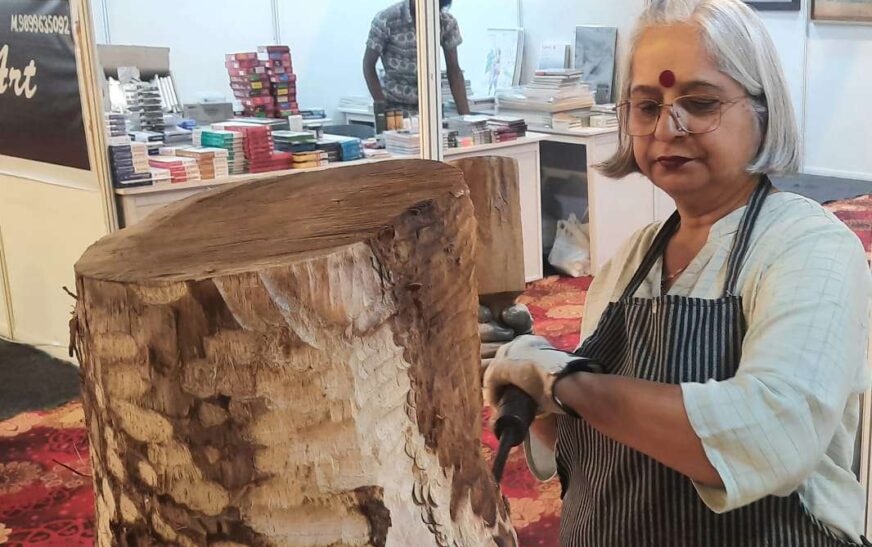Gurmeet Goldie is a virtuoso sculptor who has spent more than two decades mastering the art of transformation—moulding clay, carving wood, shaping metal, and chiselling stone into breathtaking works of sculpture. Her unwavering commitment to her craft has not only sharpened her understanding of each material’s soul but also harmonized her creations with the pulse of her inner spirit. Her sculptures radiate sensuous elegance, flowing curves, and an unmistakable vitality, creating a distinct and magnetic presence. They invite viewers into a narrative that traces her creative evolution across mediums, unified by a profound thematic resonance.
Her fascination lies in the untamed beauty of weathered stones—those marked by hollows and ridges, holding mysteries in their shadows and whispers of sunlight. Equally compelling are the sharp angles and deep recesses she explores, as though refusing to settle for a single interpretation of forms she sees as layered, enigmatic, and endlessly intriguing. Gurmeet’s work doesn’t just reflect nature; it wrestles with its complexities, embracing its unknowable depths.
In an exclusive interview with The Interview World, Gurmeet Goldie pulls back the curtain on her creative process. She reveals the inspirations behind her sculptures, the boundless opportunities available to modern sculptors, and the cutting-edge trends reshaping the art form. With sharp insight, she draws comparisons between the nuanced artistry of Indian and global sculpture, while highlighting the themes that consistently weave through her body of work. Here are the standout moments from this fascinating exchange.
Q: Can you share the types of sculptures you have created so far? Do your works revolve around a specific theme or concept?
A: Themes shift constantly, as fluid and dynamic as the world around us. Every passing day, the people we encounter and nature’s seamless transformations leave their mark on us. These moments of connection ignite the spark—a visceral trigger that drives us to create, to deliver a message through sculpture. This is where the process begins.
As social beings, our art must serve a purpose beyond aesthetics. It must speak to the heart of our shared human experience. Sculpture becomes a voice—a powerful medium to capture and reflect the complexities of society and the beauty of nature. My work focuses on this intricate interplay, where social narratives meet natural rhythms. Each piece is designed to embody these relationships, translating them into forms that resonate, provoke, and inspire.

Q: What opportunities do you see for sculptors in the future?
A: The future of sculpture is undeniably bright. When I was in college, the concept of sculpture was scarcely understood. Few truly grasped the distinction between a mural, 2D, and 3D art forms. But today, the landscape has shifted. Sculpture now commands a massive market, both in India and internationally.
People no longer view sculptures as mere adornments; they are integral to shaping the atmosphere of a space. From corporate offices to grand businesses and even private homes, sculptures are carefully chosen to elevate environments. They do more than decorate—they create an ambiance that profoundly connects with the natural world.
Q: What are the latest trends in sculpture both globally and in India, and how are they influencing contemporary art?
A: The shift is undeniable: tasks once performed by hand are now driven by groundbreaking technology. What once took hours of manual effort is now effortlessly translated by machines into captivating artwork. And the marvel doesn’t stop there—these machines can seamlessly turn digital creations into tangible, physical forms. This is the transformative trend reshaping the world of sculpture today.
Q: How do sculptures created by Indian artists differ from those crafted globally in terms of style, technique, and cultural influence? Do you have a preference or find one approach more impactful?
A: Both stand on equal ground. Art in India is contemporary, yet deeply realistic—just as much of the work outside India is. Take Henry Moore, for example. His sculptures straddle realism and abstraction with striking ease. The truth is, it doesn’t matter where an artist is from. Every artist, regardless of their background, is driven by the same goal: to convey emotion. So, making distinctions between Indian and international sculptures is not only unnecessary—it misses the heart of what art truly is.
Q: How many sculptures have you created to date, and what major themes do they explore? Which of your works has gained the most popularity?
A: I’ve created countless sculptures, though I don’t keep count. Each one speaks for itself. Every piece holds its own story. When we step out of our studios, we immerse ourselves in workshops and camps. These are the spaces where we work and grow. Take Chandigarh Lalit Kala Academy, for example, which hosts workshops every year.
My work now stands proudly at Sukhna Lake, Chandigarh—it belongs to the public. People flock to it, pausing to take photos and admire its presence. We find joy when visitors tell us, “We’ve taken pictures with your sculpture.” When art is integrated into a community, it sparks growth, fuels motivation, and nurtures inspiration. There’s no doubt about that. And wherever we go—whether it’s an exhibition or a workshop—we leave our work for the world to see, to touch, to experience.










1 Comment
Regards for this post, I am a big fan of this website would like to continue updated.
Comments are closed.